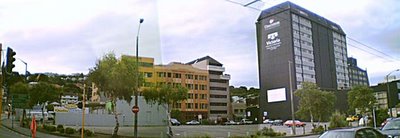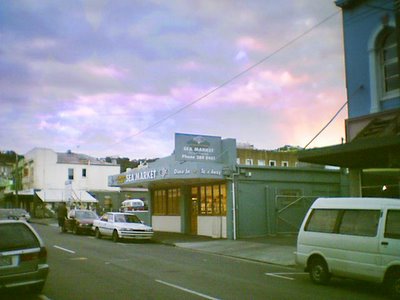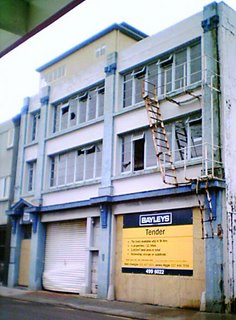On the block
File under: urbanism, Wellington
There are a number of large sites in Te Aro that are currently being offered for sale, with advertising that emphasises their "development potential". This doesn't necessarily mean that they will be built on, but it might be the first sign of some major changes in this part of town.
For each site, I've linked to the relevant commercial real estate ad. This is partly because the ads contain extra information and photos, and also because its interesting for those us not in the business to see it from their perspective. Sometimes it's quite scary to see what they consider to be the best qualities of a site: when an ad trumpets "First site off the motorway!" it hints that the intended uses might not be the most conducive to a human-scaled and pedestrian-friendly environment. So I've decided to write a little bit about the potential urban qualities of each location, and what could happen if one thinks of a site as being part of the city, rather than just a resource whose financial return must be maximised.

Site 1: Willis/Vivian/Victoria
This is a large site with just one small building on it. Apart from carparking, it's mostly only used for a few hours on Sundays, when it becomes a very popular vegetable market which would be a shame to lose. My green space map shows that it's a fair distance from any usable patches of greenery, so if some of the site could be retained as public space, it might become a useful amenity.

The depth of the site means that it would be difficult to use it all for residential development while providing adequate natural light for all the units, so perhaps this is a good opportunity for a creative interpretation of the height limits in the District Plan. I can imagine something a bit like an English covered market, with small retail units flanking an open market space and apartments above, perhaps cantilevering over the market space to provide some shelter. On the Willis St side, the market space could open out a bit to take advantage of the sun, with a few planted areas to make a more inviting public space. To compensate for the lost development space, the apartments should be able to go above the 27m (6 storey) limit in places: given the height of the Unicomm building to the north, a couple of tall, narrow towers would hardly be out of place (though the agents' renderings are hardly inspiring).
Site 2: Victoria/Walter
This site extends from the carparks next to The Mill on Victoria St through to Walter St. This could be a good opportunity to build quite densely, strengthening the scrappy streetscape of Victoria St without losing anything special. The one proviso is that it would be good to retain a pedestrian connection through the site so that Walter St is not a dead end.
Site 3: Upper Cuba St
This site is currently the home of the Cuba St Sea Market. Apart from a highly-regarded fish 'n' chip shop, most of the site is taken up by parking and portacabins, so if they're done well, new buildings here could repair a gap in the streetscape and provide much-needed new retail space.

However, that's a big "if". The controversial development of "The Wellington" hotel and apartments across the road shows that new buildings can make it through the consents process while still having dubious effects upon the streetscape. The Cuba Character Area rules (755kB PDF) may go some way to stopping the most inappropriate schemes, but they can sometimes lead to embarassing faux-historic pastiches that are far worse than if the architects had been given a free hand.
Upper Cuba St has been going through changes that continue to threaten its traditionally bohemian nature. The 'bypass' is the most glaring example, but simply tarting up a pub can be part of the same process. So any development in this precinct should perhaps be subject to greater scrutiny than just applying the planning rules. For example, while I don't think the site extends right up to the courtyard of Fidel's, it might still be possible to build within the rules and overshadow it. Should we recognise that Fidel's is an important and distinctive part of Cuba St life, and thus place special restrictions on neighbouring developments to protect it?
Site 4: Ghuznee/Egmont
On the Ghuznee St side, this is a single-storey wholesaler of lighting products; the rest of the site is carparking. It has more of an existing "urban" feel than the rest of the sites discussed, as it's only a block from the Golden Mile and it's already mostly surrounded by tall buildings. There's also an intriguing opportunity to provide an active edge and well-defined entrance to Egmont St.
It'll be interesting to see what happens once Ghuznee St ceases to be part of State Highway 1. While I'm not as optimistic as the bypass's proponents about how much the traffic would be reduced here, there's still an opportunity to make this a more pedestrian-friendly environment, so the design quality of any new building here could have a substantial impact: for better or worse.
Site 5: Lorne/Tennyson
 This huge block was the site of Pacific Catch's fish processing business, and it now looks like there'll be no more fish in the CBD. Unlike the other sites, this includes one reasonably substantial building. It's not an architectural gem, but if it were retained and restored rather than demolished, it might return a bit of character to a street that's otherwise dominated by bland temporary buildings, asphalt and chain-link fences.
This huge block was the site of Pacific Catch's fish processing business, and it now looks like there'll be no more fish in the CBD. Unlike the other sites, this includes one reasonably substantial building. It's not an architectural gem, but if it were retained and restored rather than demolished, it might return a bit of character to a street that's otherwise dominated by bland temporary buildings, asphalt and chain-link fences.This is the only one of the five sites that's in "SoCo", so are there any opportunities here to work towards the urban design qualities that I suggested for the area? My green map places it in part of the "grey zone", so perhaps this would be a good site for a small park or other public space. I tend to think not, though, because it's close to Courtenay Pl and Cambridge Tce, and while they don't count as "green spaces", they have enough life and openness respectively to fulfil some of those functions. There are some sites deeper into SoCo that could work better, as well as providing more useful mid-block connections. Any development on this site could still contribute, though, in terms of appropriate scale, provision of shelter and a mixture of uses (it's near enough to Moore Wilson that some food-related retail might work well here).



0 Comments:
Post a Comment
<< Home